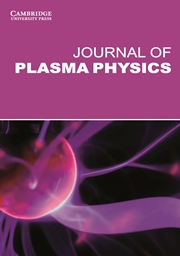Article contents
Fluctuation dynamos at finite correlation times using renewing flows
Published online by Cambridge University Press: 13 July 2015
Abstract
Fluctuation dynamos are generic to turbulent astrophysical systems. The only analytical model of the fluctuation dynamo, due to Kazantsev, assumes the velocity to be delta-correlated in time. This assumption breaks down for any realistic turbulent flow. We generalize the analytic model of fluctuation dynamos to include the effects of a finite correlation time,  ${\it\tau}$ , using renewing flows. The generalized evolution equation for the longitudinal correlation function
${\it\tau}$ , using renewing flows. The generalized evolution equation for the longitudinal correlation function  $M_{L}$ leads to the standard Kazantsev equation in the
$M_{L}$ leads to the standard Kazantsev equation in the  ${\it\tau}\rightarrow 0$ limit, and extends it to the next order in
${\it\tau}\rightarrow 0$ limit, and extends it to the next order in  ${\it\tau}$ . We find that this evolution equation also involves third and fourth spatial derivatives of
${\it\tau}$ . We find that this evolution equation also involves third and fourth spatial derivatives of  $M_{L}$ , indicating that the evolution for finite-
$M_{L}$ , indicating that the evolution for finite-  ${\it\tau}$ will be non-local in general. In the perturbative case of small-
${\it\tau}$ will be non-local in general. In the perturbative case of small-  ${\it\tau}$ (or small Strouhal number), it can be recast using the Landau–Lifschitz approach, to one with at most second derivatives of
${\it\tau}$ (or small Strouhal number), it can be recast using the Landau–Lifschitz approach, to one with at most second derivatives of  $M_{L}$ . Using both a scaling solution and the WKBJ approximation, we show that the dynamo growth rate is reduced when the correlation time is finite. Interestingly, to leading order in
$M_{L}$ . Using both a scaling solution and the WKBJ approximation, we show that the dynamo growth rate is reduced when the correlation time is finite. Interestingly, to leading order in  ${\it\tau}$ , we show that the magnetic power spectrum preserves the Kazantsev form,
${\it\tau}$ , we show that the magnetic power spectrum preserves the Kazantsev form,  $M(k)\propto k^{3/2}$ , in the large-
$M(k)\propto k^{3/2}$ , in the large-  $k$ limit, independent of
$k$ limit, independent of  ${\it\tau}$ .
${\it\tau}$ .
Information
- Type
- Research Article
- Information
- Copyright
- © Cambridge University Press 2015
References
- 10
- Cited by

